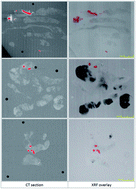Take a look at our recent HOT Analytical Methods articles, these are now free to access for the next few weeks!
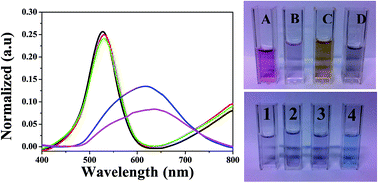
A fast and highly sensitive method for the detection of canine distemper virus by naked eye
Caroline R. Basso, Claudia C. Tozato, João Pessoa A. Junior and Valber A. Pedrosa
Anal. Methods, 2015, 7, 2264-2267
DOI: 10.1039/C4AY02644F
Simple one-step preconcentration and cleanup with micellar system for high performance liquid chromatography determination of pyrethroids in traditional Chinese medicine
Ligang Chen and Wenjuan Xing
Anal. Methods, 2015, 7, 1691-1700
DOI: 10.1039/C4AY02553A
Ammonium salting out extraction with analyte preconcentration for sub-part per billion quantitative analysis in surface, ground and drinking water by flow injection tandem mass spectrometry
Sergio C. Nanita, Laura G. Kaldon and David L. Bailey
Anal. Methods, 2015, 7, 2300-2312
DOI: 10.1039/C4AY02620A
A chronopotentiometric flow injection system for aptasensing of E. coli O157
Jiahong Lei, Jiawang Ding and Wei Qin
Anal. Methods, 2015, 7, 825-829
DOI: 10.1039/C4AY02662D
Combining a Portable, Tandem Mass Spectrometer with Automated Library Searching – An Important Step Towards Streamlined, On-Site Identification of Forensic Evidence
Adam E. O’Leary, Herbert Oberacher, Seth E. Hall and Christopher C. Mulligan
Anal. Methods, 2015, Advance Article
DOI: 10.1039/C4AY02778G
Portable Diffuse Reflectance Infrared Fourier Transform (DRIFT) Technique for the Non-invasive Identification of Canvas Ground: IR Spectra Reference Collection
M. Manfredi, E. Barberis, A. Rava, E. Robotti, F. Gosetti and E. Marengo
Anal. Methods, 2015, 7, 2313-2322
DOI: 10.1039/C4AY02006E
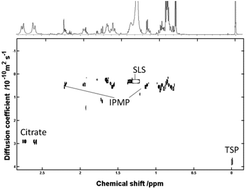 The application of high resolution diffusion NMR for the characterisation and quantification of small molecules in saliva/dentifrice slurries.
The application of high resolution diffusion NMR for the characterisation and quantification of small molecules in saliva/dentifrice slurries.
Adam Le Gresley, Emma Simpson, Alex J. Sinclair, Neil Williams, Gary R. Burnett, Dave J. Bradshaw and Robert A. Lucas
Anal. Methods, 2015, 7, 2323-2332
DOI: 10.1039/C4AY02681K
Amino Acid Composition of Human Scalp Hair as a Biometric Classifier and Investigative Lead
Ayat H. B. Rashaid, Peter B. Harrington and Glen P. Jackson
Anal. Methods, 2015, 7, 1707-1718
DOI: 10.1039/C4AY02588A
Rapid and sensitive detection of Salmonella typhimurium using aptamer conjugated carbon dots as fluorescence probe
Renjie Wang, Yi Xu, Tao Zhang and Yan Jiang
Anal. Methods, 2015, 7, 1701-1706
DOI: 10.1039/C4AY02880E
Rapid assay of neopterin and biopterin in urine by wooden-tip electrospray ionization mass spectrometry
Anal. Methods, 2015, 7, 2913-2916
DOI: 10.1039/C5AY00004A
Bi-cheng Yang, Fa-ying Liu, Jiu-bai Guo, Lei Wan, Juan Wu, Feng Wang, Huai Liu and Ou-ping Huang
Improved Monitoring of P. aeruginosa on Agar Plates
T. A. Webster, H. J. Sismaet, A. F. Sattler and E. D. Goluch
Anal. Methods, 2015, Advance Article
DOI: 10.1039/C4AY02794A
Binding interaction between prazosin and a1A-adrenoceptor: Investigation on the thermodynamic behaviours and the binding mechanism by high performance affinity chromatography
Jing Wang, Qian Li, Lingjian Yang, Yajun Zhang, Jie Yu, Xinfeng Zhao, Jianbin Zheng, Youyi Zhang and Xiaohui Zheng
Anal. Methods, 2015, Advance Article
DOI: 10.1039/C4AY03046J
Characteristics Region Extraction of Time Series Three-dimensional Fluorescence Spectroscopy
Shaohui Yu, Xue Xiao, Nanjing Zhao and Jisheng Yang
Anal. Methods, 2015, Advance Article
DOI: 10.1039/C4AY02984D
Analysis of fatty acids and triacylglycerides by Pd nanoparticle-assisted laser desorption/ionization mass spectrometry
Yuliya E. Silina, Claudia Fink-Straube, Heiko Hayen and Dietrich A. Volmer
Anal. Methods, 2015, Advance Article
DOI: 10.1039/C5AY00705D
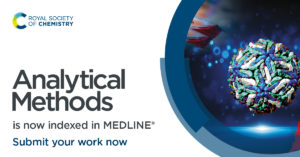 We’re pleased to announce that Analytical Methods is now indexed in MEDLINE®. This means that all articles published in Analytical Methods will now be discoverable in this key database for biomedical researchers.
We’re pleased to announce that Analytical Methods is now indexed in MEDLINE®. This means that all articles published in Analytical Methods will now be discoverable in this key database for biomedical researchers.










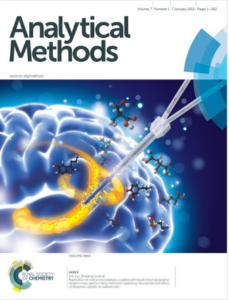






 The application of high resolution diffusion NMR for the characterisation and quantification of small molecules in saliva/dentifrice slurries
The application of high resolution diffusion NMR for the characterisation and quantification of small molecules in saliva/dentifrice slurries